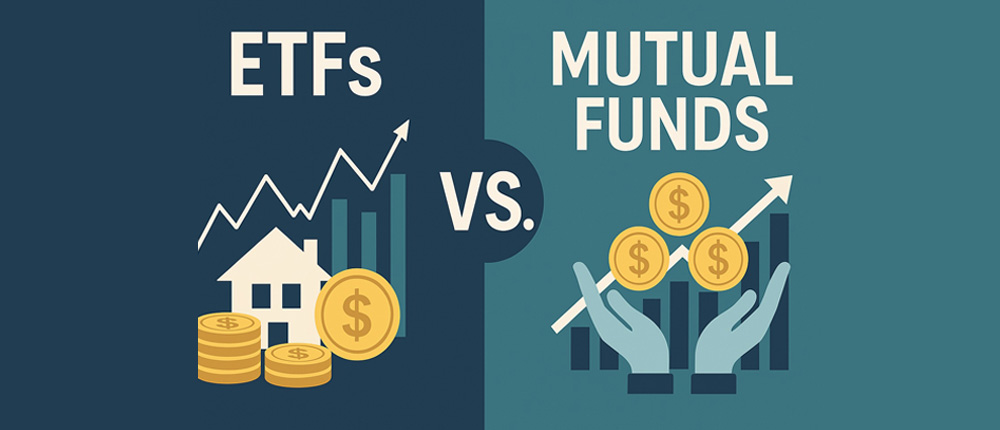
When it comes to saving for retirement, one of the smartest strategies is long-term investing in index funds. These funds aim to replicate the performance of a market index, like the S&P 500, offering broad diversification at low cost. But not all index funds are created equal. While mutual funds and ETFs (exchange-traded funds) can both serve this purpose, ETFs have emerged as the superior option for most investors—especially those focused on retirement. Here's why.
One of the most compelling advantages of ETFs is their lower expense ratios. Mutual funds often come with higher management fees and, in some cases, front- or back-end sales loads. Even index mutual funds, which are typically cheaper than actively managed funds, can carry higher expenses than ETFs.
Why does this matter? Because even a small fee difference compounds significantly over time. Consider two funds with identical returns, but one charges 0.10% annually and the other 0.80%. Over 30 years, the higher-fee fund could cost tens of thousands more in lost growth.
ETFs generally win the cost battle, and when saving for retirement, minimizing fees means maximizing your future nest egg.
ETFs are typically more tax-efficient than mutual funds. This comes down to how they’re structured. When investors redeem mutual fund shares, the fund may have to sell underlying securities, triggering capital gains for all shareholders—even those who didn’t sell.
ETFs, by contrast, use an “in-kind” redemption process. When large investors want to cash out, ETFs exchange securities directly with them, avoiding the need to sell holdings and trigger capital gains. As a result, ETFs are less likely to generate unexpected tax bills, especially in taxable accounts.
While this tax advantage may be less relevant in tax-sheltered retirement accounts (like IRAs and 401(k)s), it becomes important for anyone using a brokerage account as part of their retirement plan.
Unlike mutual funds, which are only priced once at the end of the trading day, ETFs trade on stock exchanges throughout the day like individual stocks. This gives investors the ability to:
While day trading ETFs isn't recommended for long-term retirement investing, this flexibility can still be useful. For example, if the market dips sharply in the morning, you can take advantage of that drop by buying ETFs at a discount in real-time.
Mutual fund investors don’t have that option—they’re locked into the fund’s end-of-day price, regardless of when they place their order.
Many mutual funds require a minimum investment, often ranging from $500 to $3,000 or more. This can be a barrier for younger investors just starting their retirement savings journey.
ETFs, however, are bought like stocks. You can purchase as little as a single share (and in many brokerages now, even fractional shares), making them more accessible for those with smaller amounts to invest. This makes ETFs ideal for dollar-cost averaging strategies, where you invest a consistent amount at regular intervals—an approach perfectly suited to retirement savings.
ETFs disclose their holdings daily, whereas mutual funds usually report them quarterly or monthly. This added transparency gives investors better insight into what they actually own at any given time.
For index-based ETFs, this means you can always see that the fund is accurately tracking the intended index. With mutual funds, there’s often more of a delay in knowing exactly how your money is invested.
While both mutual funds and ETFs offer access to popular indexes like the S&P 500 or total market indexes, ETFs have exploded in popularity and variety. There are now thousands of ETFs covering:
This wide range gives investors more flexibility to build a diversified retirement portfolio that aligns with their specific goals, risk tolerance, and values.
More and more retirement accounts—including employer-sponsored plans and individual IRAs—now allow ETF investing. Platforms like Fidelity, Vanguard, Schwab, and others offer commission-free trading on a wide selection of ETFs.
As retirement planning evolves, ETFs are becoming a staple of modern investment platforms thanks to their versatility and investor-friendly features.
When it comes to building wealth for retirement, indexing is a time-tested and proven strategy. But choosing the right vehicle matters just as much as choosing the right strategy. For most investors, ETFs provide a better overall experience than mutual funds—offering lower costs, more tax efficiency, easier access, and greater flexibility.
While mutual funds still have their place, particularly in employer-sponsored plans that may not yet offer ETF options, ETFs are quickly becoming the go-to choice for modern retirement savers. If you're not already using them in your retirement plan, it might be time to consider making the switch—and letting those fee savings work for your future.